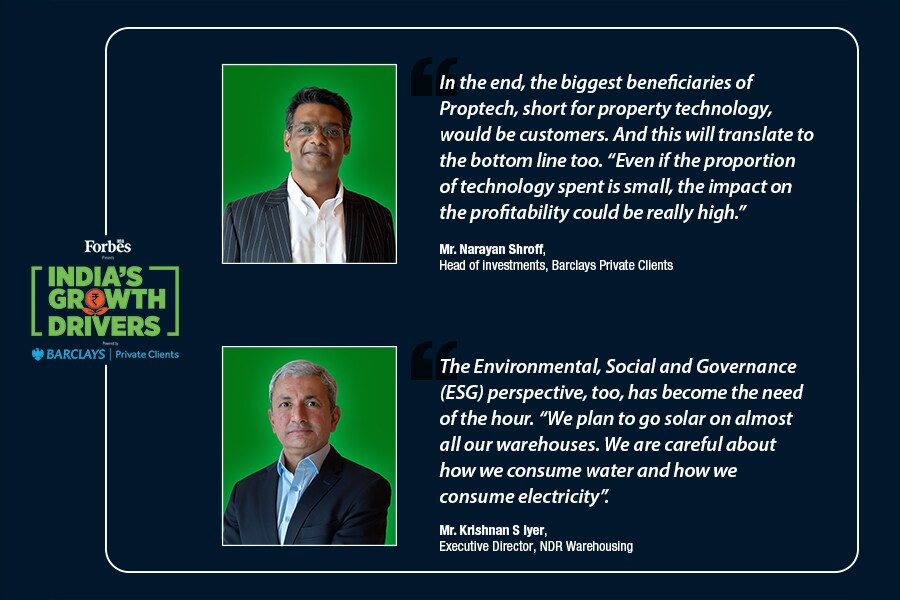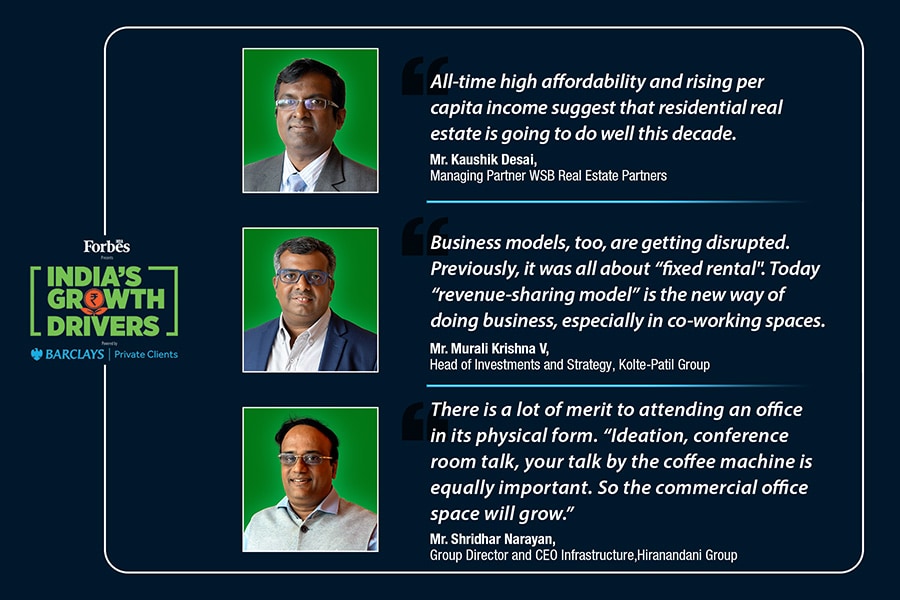Space to Grow: The real estate roundtable
In an engaging roundtable discussion, industry stalwarts talk about exciting opportunities of the real estate sector in the post-pandemic world


 Over the last many decades, the real estate sector has remained resilient in the face of countless challenges and pressures. The pandemic, an unprecedented once-in-a-century event, slammed the brakes on many industries.
Over the last many decades, the real estate sector has remained resilient in the face of countless challenges and pressures. The pandemic, an unprecedented once-in-a-century event, slammed the brakes on many industries.
The real estate sector, however, has figured out ways to survive through innovative use of technology and change in business models. To understand this renewed sense of optimism and discuss how medium to long term projections will translate into action, Forbes India and Barclays collaborated on “Space to Grow", the Real Estate Roundtable.
What followed was a riveting panel discussion among Mr. Narayan Shroff, Head of investments, Barclays Private Client Mr. Kaushik Desai, Managing Partner WSB Real Estate Partners (formerly “Walton Street India") Mr. Murali Krishna V, Head of Investments and Strategy, Kolte-Patil Group Shridhar Narayan, Group Director and CEO Infrastructure, Hiranandani Group and Mr. Krishnan Iyer, Executive Director, NDR warehousing.
The pandemic forced everyone indoors and “we discovered our housing market from a different parlance", said Mr. Shroff. The typical theme was “work from home". Today, there is a lot of demand for more space in residential real estate.

The definition of “office" has changed
On the commercial side, however, he felt that “a hybrid model" would be here to stay and that the industry should prepare itself for this new order.
Mr Krishna, on the other hand, believed that the shakeup on account of the pandemic was only temporary. Companies that laid off thousands of employees would eventually turn a corner and recruit in droves. Despite the hybrid nature of work, there will always be a robust demand for commercial real estate. “Most real estate developers are doing better than they were during the pre-pandemic time," he said.
From affordable housing to affordable luxury
After the nationwide lockdowns, the real estate sector has seen “a V shape recovery", said Mr Desai. With almost all members of the family having to squeeze in their meetings and classes over laptops, the need for bigger homes has been higher than ever before. “You need to plan for these things. There was a realisation that there is a need for a good house. This has enabled an uptick in demand", he said.
“Earlier it was all about affordable housing", agreed Mr Narayan. Now it’s about “affordable luxury". The modern consumer wants utility but not at prohibitive rates. Also, what was previously construed as a luxury has now become a necessity. This is largely down to the pandemic when people had to find new ways of surviving, both personally and professionally.
Warehousing: Taking flight
Warehouses were among the few sub-segments that grew at a scorching pace during the pandemic. “We grew the most during the pandemic", said Mr Iyer. It wasn’t a cakewalk, he admits. “It was tough to find the right manpower and material, but we did it somehow". A whopping 2.5-3 million square feet of warehousing needs were met in quick time. At the same time, the clients are ever so demanding and “want a project to be done in the minimum possible time with the same quality".
Whereas warehousing needs grew exponentially, the pandemic also had an impact on the traditional office environment. In the short term, work from home became the norm but not every task can be accomplished remotely over a consistent period of time.
Office serendipity spurs innovation
There is a lot of merit to attending an office in its physical form. “Ideation, conference room talk, your talk by the coffee machine is equally important. So the commercial office space will grow", said Mr Narayan while pointing to the serendipitous moments that physical spaces allow for unlike virtual meetings that are planned in advance.
For the real estate sector to grow consistently, the allied infrastructure, too, needs to get a fillip. In that regard, the government deserves a lot of credit, reckoned Mr Iyer. Before the pandemic, about 20-24km of roads were being built daily. Today, the figure is around 35-36km, a staggering feat.

Unlearn old business models to imbibe new ones
Business models, too, are getting disrupted. Previously, it was all about “fixed rental"". Today “revenue-sharing model" is the new way of doing business, said Mr Krishna. Similarly, unlike the traditional model where warehouses were leased at one go, today, “data centres pay based on the number of racks or servers they put in", said Mr Iyer.
All in all though, a paradigm shift in the sector will be brought about by technology, said Mr Shroff. Applications of technology like Artificial Intelligence and 3D printing will bring in efficiencies, he said. Big data, for instance, can be harnessed for predictive analytics to decide a space, sales strategy, understanding the customer’s tastes and preferences and even the building infrastructure, said Mr Krishna.
Data can be “sliced and diced", said Mr Desai to garner meaningful insights. “I think it’s going to play a very important part and there’s a huge scope for it". He also pointed to some “positive macros" too. “Affordability is at an all-time high and per capita income is increasing". This bodes well for the entire sector in general. “It’s a good time for the real estate sector in the next decade and I am very optimistic about it."
Some outfits, including his own, have even used drones to monitor projects, said Mr Iyer. In the long term, the outlook for the sector is “very positive", he added. The Environmental, Social and Governance (ESG) perspective, too, has become the need of the hour. “We plan to go solar on almost all our warehouses. We are careful about how we consume water and how we consume electricity".
Small wonder that there are around 1,077 real estate tech startups in India, according to Traxn, a data provider. The pandemic has turned out to be a catalyst for the real estate sector, both commercial and residential, to reinvent itself.
In the end, the biggest beneficiaries of the transformation would be customers. And this will translate to the bottom line too. “Even if the proportion of technology spent is small, the impact on the profitability could be really high", said Mr Shroff.
Proptech, short for property technology, will pave the way for the future of real estate by applying information technology and platform economics to real estate markets. The primitive sector is primed for one-of-a-kind change that will benefit both the consumers and developers through innovative use of technology and business models.
The pages slugged ‘Brand Connect’ are equivalent to advertisements and are not written and produced by Forbes India journalists.
First Published: Aug 29, 2022, 21:03
Subscribe Now